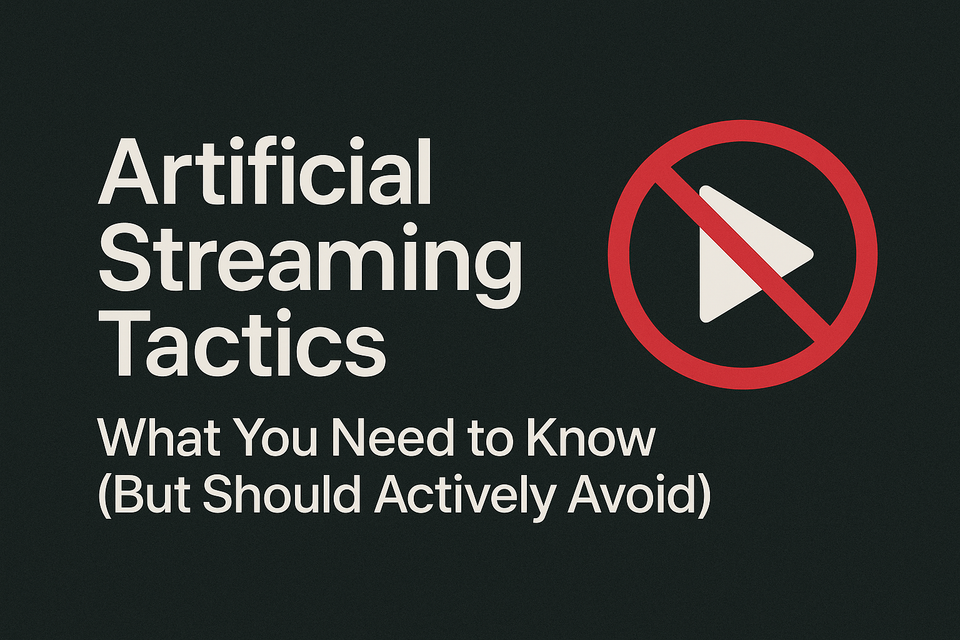Artificial Streaming Tactics: What You Need to Know (But Should Actively Avoid)

An analytical warning for independent labels and serious music creators
Artificial streaming is a persistent part of today’s music ecosystem.
It doesn’t matter whether you support it or not – it exists.
This article outlines how manipulation works, why it sometimes appears to succeed, and what the long-term consequences are for everyone involved in serious music distribution.
Here structured overview of risks you should be aware of – especially if you’re working honestly.
1. What Platform Manipulation Actually Looks Like
The following tactics are commonly used by actors trying to simulate organic growth. Some are offered by third-party services. Others are embedded in traffic or playlist tools.
Bot traffic and click farms
Streams are generated by fake accounts or scripted devices, often geo-targeted to appear “normal”. Some methods use embedded widgets. Others spoof browser behavior.
Playlist loops through smartlink redirects
Autoplay-enabled links or redirects trick the system into counting a stream, even if the user doesn’t interact with the content directly.
Artificial saves and follower boosts
Automated networks simulate engagement to trigger algorithmic playlists. These actions rarely lead to genuine fan interest.
Ad-based traffic manipulation
Some services run very cheap traffic through popunder ads or redirect platforms. It appears as external discovery – but user behavior proves otherwise.
⚠️ What is “Fake Discovery via Ad Traffic”?
This tactic simulates Spotify discovery by using low-quality ads that force streams.
Most common sources include:
– Popunder ads
– Interstitial redirects
– Low-cost “junk traffic” networks
The result:
– Skips, not plays
– No saves
– No real engagement
While it may take time for Spotify to flag this pattern, the system will eventually respond.
2. Why These Tactics Appear Effective at First
Platforms like Spotify react to behavior, not motivation. If a track shows a sudden rise in plays, saves, or listener activity, it may trigger features like Release Radar or Autoplay.
That’s why artificial campaigns can sometimes create a short-term spike.
But this kind of data doesn’t hold up. Skips increase. Save rates stay low. Followers don’t grow.
And over time, the system adjusts.
3. What Follows: Silent Penalties and Hidden Blocks
Platforms rarely send warnings. Instead, they suppress visibility quietly:
• Streams disappear from the public dashboard
• Royalties may be withheld
• Artist profiles are shadowbanned – not officially, but algorithmically
• Some distributors cancel accounts based on fraud patterns
Even one flagged release can affect future visibility.
You won’t get notified. You’ll just stop being found.
4. Why It’s Not Just a Risk – It’s a Liability
Manipulating platform data violates nearly every distribution agreement.
The consequences are not theoretical:
• Takedowns
• Royalty reversals
• Contract terminations
• Blacklisting from DSPs (especially Apple and Tidal)
Some rights holders have even faced legal consequences for repeat offenses.
5. What Clean, Real Growth Actually Looks Like
If you’re building your catalog seriously, this is the data you should watch:
• Stream-to-listener ratio
• Save rate over time
• Return listeners
• Playlist adds from real user lists (not networks)
• Organic follower growth
These numbers don’t explode overnight – but they hold.
6. How to Recognize Red Flags – Before It’s Too Late
Not all manipulation is self-inflicted.
Sometimes, tracks are added to playlists or networks that harm your data profile without your involvement. That’s why it’s important to monitor your traffic sources and growth patterns carefully.
Here are warning signs that your content might be exposed to artificial behavior:
• Playlists with extremely high stream counts but very few followers
If your track gets thousands of plays but the playlist has only a handful of followers – the traffic might not be organic.
• Sudden follower surges followed by quick drop-offs
Real fan growth happens slowly. Sudden jumps followed by reversals suggest automated campaigns or bought audiences.
• Traffic sources marked as “other” or “unknown” in analytics
Untraceable sources can mean forced traffic from shady networks.
• Unusually low save or repeat rates despite high play counts
If many people “listen” – but almost no one saves or returns – those weren’t real listeners.
• Multiple playlist adds within hours – with no genre or mood consistency
That’s a typical pattern of artificial playlist networks testing placements.
If you notice one or more of these signs, it’s time to re-evaluate your distribution channels and traffic partners.
Not every campaign is helpful – and some can damage your long-term visibility.
Conclusion
You don’t need artificial metrics to build a long-term career.
You need clarity, patience, and understanding of how platforms actually respond to engagement.
If your numbers are clean, they’ll work for you – over time.
If they’re inflated, they’ll collapse the moment the system checks twice.
Sources & Further Reading
- Spotify for Artists – Guidelines on Artificial Streaming Official overview of prohibited behavior, including bot traffic, stream manipulation, and the consequences.
- Spotify Legal – Terms and Conditions of Use Spotify’s general rules for user behavior and platform usage.
- Billboard – What Counts as a Legit Stream in 2024? Industry-level discussion on the manipulation of streaming data and how platforms react.
- Music Business Worldwide – The Real Problem with Fake Streams In-depth look at why artificial reach undermines the industry.
- Chartmetric – What Artificial Streaming Looks Like Concrete signs and patterns that may indicate manipulated activity, with a focus on analytics.
- YouTube – Spotify Playlist Promo Scams (Adam Ivy) Educational breakdown of how common Spotify playlist scams operate.
View all articles about Spotify
NexaTunes – structured support for independent releases.
Get in touch for more information using our livechat
